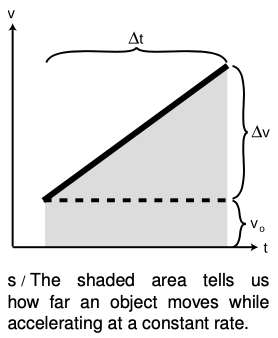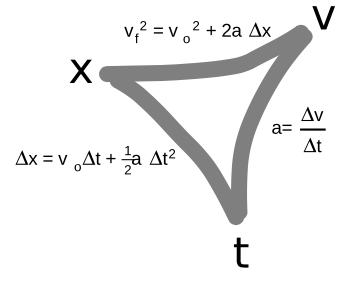LM 3_6 Algebraic results for constant acceleration Collection
Tags | |
UUID | 1f31b85b-f145-11e9-8682-bc764e2038f2 |
3.6 Algebraic Results for Constant Acceleration by Benjamin Crowell, Light and Matter licensed under the Creative Commons Attribution-ShareAlike license.
3.6 Algebraic results for constant acceleration
Although the area-under-the-curve technique can be applied to any graph, no matter how complicated, it may be laborious to carry out, and if fractions of rectangles must be estimated the result will only be approximate. In the special case of motion with constant acceleration, it is possible to find a convenient shortcut which produces exact results. When the acceleration is constant, the v - t graph is a straight line, as shown in the figure. The area under the curve can be divided into a triangle plus a rectangle, both of whose areas can be calculated exactly: A=b⋅h for a rectangle and A=12b⋅h for a triangle. The height of the rectangle is the initial velocity, vo, and the height of the triangle is the change in velocity from beginning to end Δv. The object's Δx is therefore given by the equation Δx=voΔt+12ΔvΔt⋅Δt2 . This can be simplified a little by using the definition of acceleration, a= Δv/Δt, to eliminate Δv, giving
Δx=v0⋅Δt+12a⋅Δt2. [motion with constant acceleration]
Since this is a second-order polynomial in Δt, the graph ofΔx versus Δt is a parabola, and the same is true of a graph of x versus t the two graphs differ only by shifting along the two axes. Although I have derived the equation using a figure that shows a positive vo, positive a, and so on, it still turns out to be true regardless of what plus and minus signs are involved.
 Another useful equation can be derived if one wants to relate the change in velocity to the distance traveled. This is useful, for instance, for finding the distance needed by a car to come to a stop. For simplicity, we start by deriving the equation for the special case of vo=0, in which the final velocity vf is a synonym forΔv. Since velocity and distance are the variables of interest, not time, we take the equation Δx=12aΔt2 and use Δt=Δva to eliminateΔt. This gives Δx=(Δv)22a, which can be rewritten as
Another useful equation can be derived if one wants to relate the change in velocity to the distance traveled. This is useful, for instance, for finding the distance needed by a car to come to a stop. For simplicity, we start by deriving the equation for the special case of vo=0, in which the final velocity vf is a synonym forΔv. Since velocity and distance are the variables of interest, not time, we take the equation Δx=12aΔt2 and use Δt=Δva to eliminateΔt. This gives Δx=(Δv)22a, which can be rewritten as
v2f=2aΔx . [motions with constant acceleration, v0 = 0]
For the more general case where v0 ≠ 0, we skip the tedious algebra leading to the more general equation,
v2f=v20+2aΔx . Solved for vf=√v20+2⋅a⋅Δx [motion with constant acceleration]
To help get this all organized in your head, first let's categorize the variables as follows:
Variables that change during motion with constant acceleration:
x,v,t
Variable that doesn't change:
a
If you know one of the changing variables and want to find another, there is always an equation that relates those two:

The symmetry among the three variables is imperfect only because the equation relating x and t includes the initial velocity.
Δt=√2Δxa
There are two main difficulties encountered by students in applying these equations:
- The equations apply only to motion with constant acceleration. You can't apply them if the acceleration is changing.
- Students are often unsure of which equation to use, or may cause themselves unnecessary work by taking the longer path around the triangle in the chart above. Organize your thoughts by listing the variables you are given, the ones you want to find, and the ones you aren't given and don't care about.
Example 7: Saving an old lady
⇒ You are trying to pull an old lady out of the way of an oncoming truck. You are able to give her an acceleration of 20m/s2. Starting from rest, how much time is required in order to move her 2 m?
⇒ First we organize our thoughts:
Variables given: Δx,a,vo
Variables desired: Δt
Irrelevant variables: vf
Consulting the triangular chart above, the equation we need is clearly Δx=v0⋅Δt+12a⋅Δt2, since it has the four variables of interest and omits the irrelevant one. Eliminating the vo term and solving for Δt gives Δt=√2Δxa=0.4 s.
⇒ Solved problem: A stupid celebration — problem 15
⇒ Solved problem: Dropping a rock on Mars — problem 16
⇒ Solved problem: The Dodge Viper — problem 18
⇒ Solved problem: Half-way sped up — problem 22
Discussion Questions
A In chapter 1, I gave examples of correct and incorrect reasoning about proportionality, using questions about the scaling of area and volume. Try to translate the incorrect modes of reasoning shown there into mistakes about the following question: If the acceleration of gravity on Mars is 1/3 that on Earth, how many times longer does it take for a rock to drop the same distance on Mars?
B Check that the units make sense in the three equations derived in this section.
3.6 Algebraic Results for Constant Acceleration by Benjamin Crowell, Light and Matter licensed under the Creative Commons Attribution-ShareAlike license.
Equations
- Rectangle Area KurtHeckman Use Equation
- Area of Triangle (base and height) KurtHeckman Use Equation
- Distance - initial velocity and constant acceleration KurtHeckman Use Equation
- Final Velocity - f(a,dx) KurtHeckman Use Equation
- Distance - v0 and Δv/Δt vCollections Use Equation
- Distance using acceleration and time vCollections Use Equation
- time Δt=Δva vCollections Use Equation
- Distance - Δx=(Δv)22a vCollections Use Equation
- time for distance with constant acceleration vCollections Use Equation
- Distance Traveled at Constant Acceleration KurtHeckman Use Equation
- Acceleration from Change in Velocity and Change in Time MichaelBartmess Use Equation
- Comments
- Attachments
- Stats
No comments |
